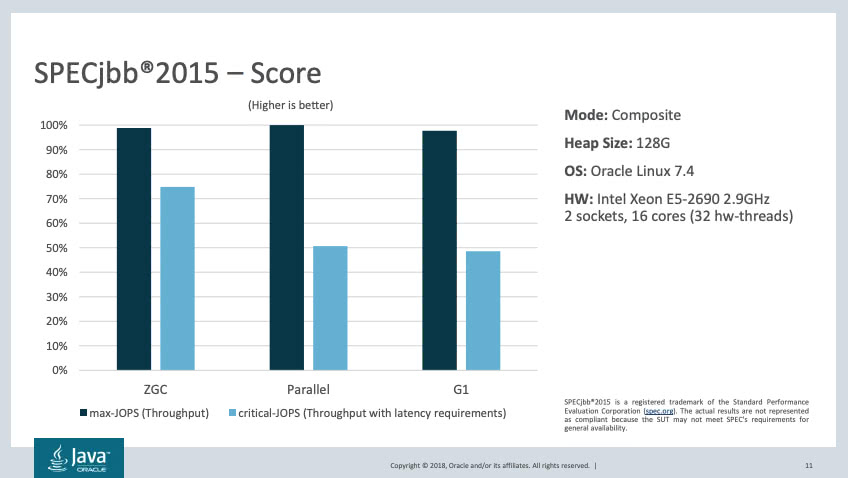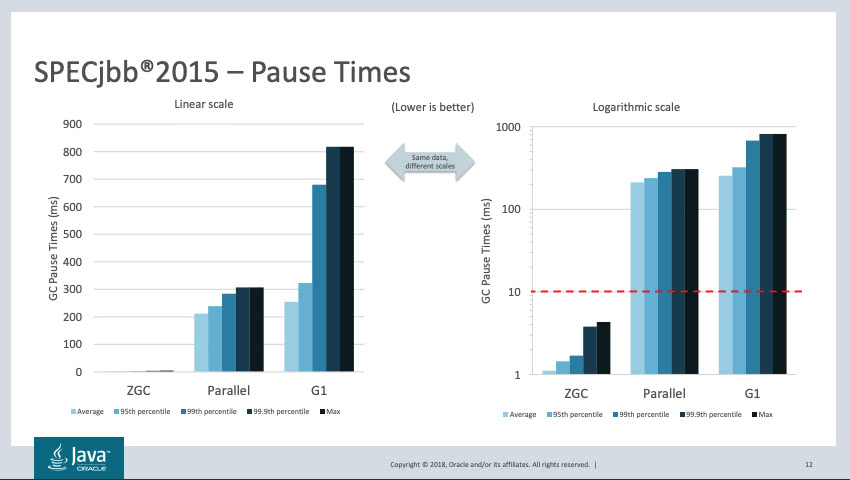ZGC, The Z Garbage Collector
scalable low-latency garbage collector
- 개요
- ZGC의 목표
- 어떻게 사용하는가?
- 테스트 결과
- HotSpot Virtual Machine Garbage Collection Tuning Guide (Java 17) The Z Garbage Collector 번역
- 참고문헌
- 주석
개요
The Z Garbage Collector, also known as ZGC, is a scalable low-latency garbage collector.1
ZGC는 확장 가능한 낮은 레이턴시의 GC이다.
- Low Latency: GC 일시 정지 시간이 10ms 미만이다.
- Scalable: heap 사이즈나 라이브셋의 사이즈가 커져도 일시 정지 시간이 늘어나지 않는다.
ZGC의 목표
- GC pause times should not exceed 10ms
- Handle heaps ranging from relatively small (a few hundreds of megabytes) to very large (many terabytes) in size
- No more than 15% application throughput reduction compared to using G1
- Lay a foundation for future GC features and optimizations leveraging colored pointers and load barriers
- Initially supported platform: Linux/x641
간단히 번역해 보자면 다음과 같다.
- GC 일시 정지 시간이 10ms를 초과하지 않아야 한다.
- 비교적 작은(수백 MB) 크기에서 매우 큰(수 TB) 사이즈의 heap을 다룰 수 있어야 한다.
- G1 보다 애플리케이션 처리율이 15% 이상 떨어지지 않을 것.
- colored pointers, load barriers를 사용하여 미래의 GC를 위한 기능/최적화 기반을 마련한다.
- 최초 지원 플랫폼은 Linux/x64.
즉 ZGC의 목표는 G1보다 더 짧은 latency를 가지면서 G1보다 크게 뒤쳐지지 않는 처리율을 갖는 것이다.
ZGC를 개발한 이유에 대해 더 자세히 알아보자.
Garbage collection is one of Java's main strengths. However, when garbage collection pauses become too long they start to affect application response times negatively. By removing or drastically reducing the length of GC pauses, we'll make Java a more attractive platform for an even wider set of applications.
Furthermore, the amount of memory available in modern systems continues to grow. Users and application developers expect the JVM to be equipped to take full advantage of this memory in an efficient manner, and without long GC pause times.
두 가지로 요약할 수 있다.
- GC 일시 정지를 최소화한다.
- 대량의 메모리를 최대한 효율적으로 사용하는 GC의 개발.
어떻게 사용하는가?
(참고: 세 버전의 튜닝 가이드(Java SE 11, Java SE 12, Java SE 13)의 ZGC 항목이 동일하다.)
ZGC는 대기 시간이 낮은 확장 가능한(scalable low latency) GC이다. ZGC는 모든 종류의 비싼 작업을 동시에(concurrently) 작업하며, 애플리케이션 스레드의 실행을 중지하지 않는다는 특징이 있다.
ZGC는 10ms 미만의 짧은 대기 시간이 필요하거나 테라 바이트 큐모의 매우 큰 heap을 사용하는 애플리케이션을 위한 GC이다.
ZGC는 JDK 11부터 실험적으로 도입되었다.
ZGC는 JDK 11, 12, 13에서 -XX:+UnlockExperimentalVMOptions XX:+UseZGC 두 옵션을 켜서 활성화할 수 있다.
ZGC 튜닝에서 가장 중요한 것은 -Xmx로 설정할 수 있는 최대 힙 크기이다. ZGC는 동시 콜렉터이기 때문에,
- heap이 애플리케이션의 라이브셋을 수용할 수 있고,
- heap에서 GC가 돌아가는 동안 할당을 처리할 수 있을만큼의 충분한 여유 공간이 있어야 한다.
일반적으로 ZGC는 메모리가 많으면 많을수록 좋다고 한다.
ZGC 튜닝에서 두 번째로 중요한 것은 동시에 가동하는 GC 스레드의 수이다. -XX:ConcGCThreads로 설정할 수 있으며, ZGC는 휴리스틱을 통해 이 값을 자동으로 선택한다. 다만, 이 값이 너무 크면 GC가 애플리케이션의 CPU 시간을 다 빼앗아버리므로 처리율이 떨어진다. 반면 이 값이 너무 작으면 쓰레기 수거보다 쓰레기가 쌓이는 속도가 더 빠를 수 있다.
테스트 결과
한편 ZGC project의 리드인 Per Liden이 FOSDEM 2018에서 발표한 자료를 보면 SPECjbb에서 2015년에 수행한 테스트 결과가 실려 있다.

- 레이턴시에 대한 요구 조건이 있는 상황에서도 ZGC의 처리율이 G1보다 괜찮았다.

- 일시 정지 시간도 압도적으로 짧았다.
HotSpot Virtual Machine Garbage Collection Tuning Guide (Java 17) The Z Garbage Collector 번역
The Z Garbage Collector (ZGC) is a scalable low latency garbage collector. ZGC performs all expensive work concurrently, without stopping the execution of application threads for more than a few milliseconds. It is suitable for applications which require low latency. Pause times are independent of heap size that is being used. ZGC supports heap sizes from 8MB to 16TB.
The Z Garbage Collector is enabled with the command-line option
-XX:+UseZGC.
- ZGC는 확장 가능한 low latency GC 입니다.
- ZGC는 모든 비싼 작업들을 concurrently하게 수행하는데, 그러면서도 애플리케이션 스레드들이 약간의 millisecond 이상 멈추지 않도록 합니다.
- 따라서 ZGC는 low latency를 요구하는 애플리케이션에 적합합니다.
- 정지 시간은 사용되고 있는 heap의 크기와 무관합니다.
- ZGC는 8MB부터 16TB까지의 heap 크기를 지원합니다.
- ZGC는 커맨드 라인에서
-XX:+UseZGC옵션을 주면 사용할 수 있습니다.
Setting the Heap Size
The most important tuning option for ZGC is setting the max heap size (-Xmx). Since ZGC is a concurrent collector a max heap size must be selected such that, 1) the heap can accommodate the live-set of your application, and 2) there is enough headroom in the heap to allow allocations to be serviced while the GC is running. How much headroom is needed very much depends on the allocation rate and the live-set size of the application. In general, the more memory you give to ZGC the better. But at the same time, wasting memory is undesirable, so it’s all about finding a balance between memory usage and how often the GC needs to run.
- ZGC 튜닝에서 가장 중요한 것은 max heap size 설정입니다(
-Xmx). - ZGC는 concurrent collector이며, 다음의 이유들로 인해 max heap size를 반드시 선택해야 합니다.
- heap이 애플리케이션의 live-set을 수용할 수 있어야 합니다.
- heap에서 allocation을 수행하는 동안 GC가 수행될 수 있도록 headroom이 충분히 있어야 합니다.
- 얼마나 많은 headroom이 필요한지는 애플리케이션의 live-set 크기와 allocation rate에 따라 달라집니다.
- 일반적으로는 ZGC에 제공하는 메모리가 많으면 많을수록 좋습니다.
- 하지만 그렇다고 메모리를 낭비하는 것은 바람직하지 않겠죠. 메모리 사용량과 GC 수행 빈도 사이의 균형을 찾아야 합니다.
Setting Number of Concurrent GC Threads
The second tuning option one might want to look at is setting the number of concurrent GC threads (
-XX:ConcGCThreads). ZGC has heuristics to automatically select this number. This heuristic usually works well but depending on the characteristics of the application this might need to be adjusted. This option essentially dictates how much CPU-time the GC should be given. Give it too much and the GC will steal too much CPU-time from the application. Give it too little, and the application might allocate garbage faster than the GC can collect it.
- 두 번째로 중요한 튜닝 옵션은 concurrent GC 스레드 수를 설정(
-XX:ConcGCThreads)하는 것입니다. - ZGC는 휴리스틱을 통해 이 스레드 수를 자동으로 선택합니다.
- 이 휴리스틱은 애플리케이션의 특성에 따라 잘 작동할 수 있지만, 조정이 필요할 수도 있습니다.
- 즉 이 옵션은 CPU-time 중 얼마만큼을 GC에게 줄 것인지를 설정하는 것입니다.
- 이 값을 너무 크게 주면 GC가 애플리케이션의 CPU-time을 그만큼 많이 잡아먹게 됩니다.
- 이 값을 너무 작게 주면 애플리케이션이 GC가 쓰레기를 수집하는 것보다 더 빠르게 쓰레기를 할당하게 됩니다.
Returning Unused Memory to the Operating System
By default, ZGC uncommits unused memory, returning it to the operating system. This is useful for applications and environments where memory footprint is a concern. This feature can be disabled using
-XX:-ZUncommit. Furthermore, memory will not be uncommitted so that the heap size shrinks below the minimum heap size (-Xms). This means this feature will be implicitly disabled if the minimum heap size (-Xms) is configured to be equal to the maximum heap size (-Xmx).An uncommit delay can be configured using
-XX:ZUncommitDelay=<seconds>(default is 300 seconds). This delay specifies for how long memory should have been unused before it's eligible for uncommit.
- 기본적으로, ZGC는 사용되지 않은 메모리를 uncommit하고 운영체제로 반환합니다.
- 이 기능은 메모리 footprint가 중요한 애플리케이션 및 환경에 적합합니다.
- 이 기능은
-XX:-ZUncommit를 사용하여 비활성화할 수 있습니다. - 한편, 메모리 uncommit은 uncommit으로 인해 heap 사이즈가 minimum heap size(
-Xms)보다 작아지는 경우에는 수행되지 않습니다. - 만약 minimum heap size(
-Xms)가 maximum heap size(-Xmx)와 같게 설정되었다면, 이 기능은 암묵적으로 비활성화됩니다. - uncommit delay는
-XX:ZUncommitDelay=<seconds>를 사용하여 설정할 수 있습니다.- 디폴트 값은 300초.
- 이 delay 값만큼의 시간이 지나는 동안 메모리가 사용되지 않는다면 uncommit이 가능하게 됩니다.
참고문헌
- 웹 문서
- JEP 333: ZGC: A Scalable Low-Latency Garbage Collector (Experimental)
- HotSpot Virtual Machine Garbage Collection Tuning Guide(Java SE 11)
- HotSpot Virtual Machine Garbage Collection Tuning Guide(Java SE 12)
- HotSpot Virtual Machine Garbage Collection Tuning Guide(Java SE 13)
- HotSpot Virtual Machine Garbage Collection Tuning Guide(Java SE 17)
- The Z Garbage Collector An Introduction
- The Design of ZGC
- CFV: New Project: ZGC
- 동영상